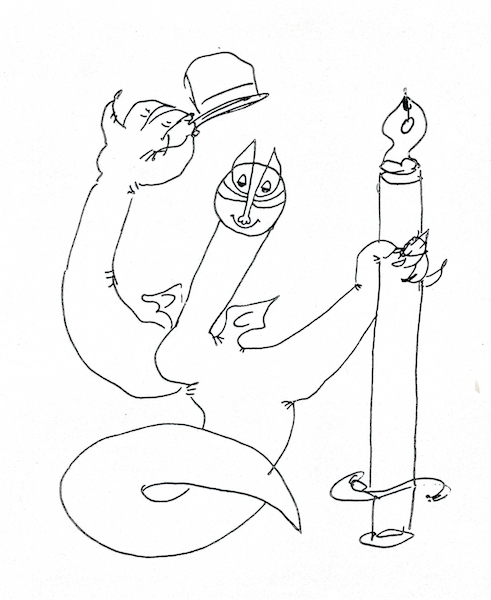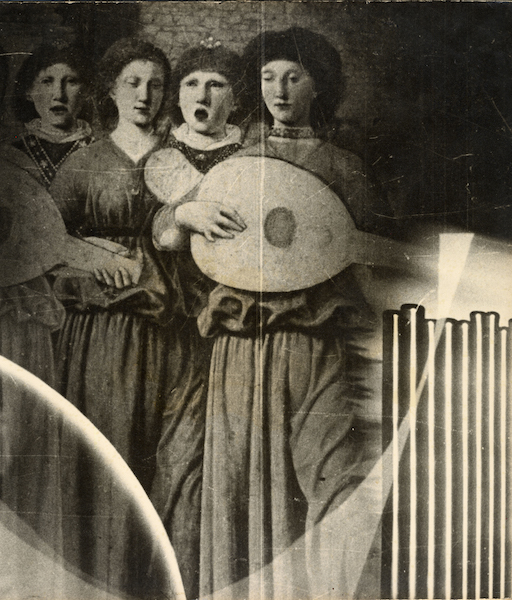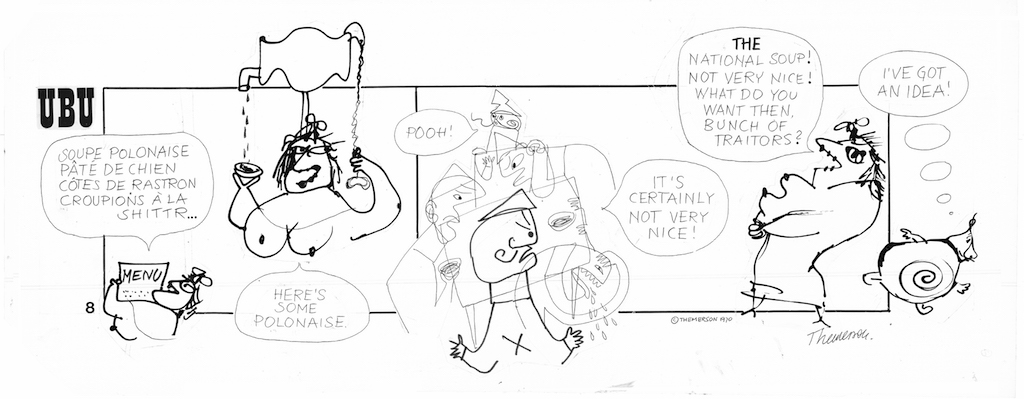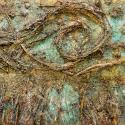Bertrand Russell’s History of the World is a charming little booklet that carries a chilling message: “Since Adam and Eve ate the apple, man has never refrained from any folly of which he is capable.” A line drawing shows Adam and Eve sharing a neatly sliced apple followed by a comic depiction of medieval warfare. Next comes “The End” printed opposite a photo of a mushroom cloud. The juxtaposition of image and text drives home the point; all the polemics in the world couldn’t make a clearer case for nuclear disarmament.
The booklet was published by the Gaberbocchus Press (colophon pictured below right), whose goal was to produce books that were “best lookers” rather than “best sellers”, in which the visuals are as important as the text. The lines of Apollinaire’s poem Il Pleut (It Rains), for instance, trickle down the page like incessant drizzle. The letters of Stefan Themerson’s poem Enjoy your bath... jump about like bubbles “bobbing up and down on the surface”, even though the poem warns that appearances can be deceptive: “all the waters of the world will harden/ into sharp cold crystals of hate sparkling with millions of enchanting rainbows”.
 Set up in 1948 by Franciszka and Stefan Themerson, the press was named after a spoof Latin translation of Lewis Carroll’s Jabberwocky; the opening phrase “T’was brillig” becomes “Hora aderat briligi”! Carroll’s darkly nonsensical humour appealed to the Themersons, who left Poland just before World War Two and came to London, via Paris.
Set up in 1948 by Franciszka and Stefan Themerson, the press was named after a spoof Latin translation of Lewis Carroll’s Jabberwocky; the opening phrase “T’was brillig” becomes “Hora aderat briligi”! Carroll’s darkly nonsensical humour appealed to the Themersons, who left Poland just before World War Two and came to London, via Paris.
The couple made a great team. Franciszka, who was also a painter, designed and illustrated these enchanting books, while Stefan wrote the poems, novels, essays and children’s stories which they published alongside the work of avant-garde authors like Guillaume Apollinaire and Kurt Schwitters. But their efforts weren’t much appreciated here in Britain. In 1962 the librarian of the Belsize Branch Library refused an offer of three books, including Stefan’s monograph on the German dadaist Schwitters, on the grounds that they would add little to the collection.
 Such indifference must have been especially disappointing since, in Warsaw, they’d been key members of the avant-garde, setting up the Polish Film-makers’ Co-op and making surrealist films inspired by French counterparts, such as René Clair’s Entr’acte, 1924. On show is The Adventure of a Good Citizen, 1937, in which people discover the freedom of walking backwards. Two men carry a wardrobe through the streets and into the woods; cue euphoric shots of light filtering through trees and Tommy Cooper-style gags based on reflections in the wardrobe mirror. The men are followed by a protest march whose members climb through the wardrobe and emerge into a utopian realm, where the furniture-movers fly like birds and play the flute like angels.
Such indifference must have been especially disappointing since, in Warsaw, they’d been key members of the avant-garde, setting up the Polish Film-makers’ Co-op and making surrealist films inspired by French counterparts, such as René Clair’s Entr’acte, 1924. On show is The Adventure of a Good Citizen, 1937, in which people discover the freedom of walking backwards. Two men carry a wardrobe through the streets and into the woods; cue euphoric shots of light filtering through trees and Tommy Cooper-style gags based on reflections in the wardrobe mirror. The men are followed by a protest march whose members climb through the wardrobe and emerge into a utopian realm, where the furniture-movers fly like birds and play the flute like angels.
In England, the Themersons continued to make films such as The Eye and the Ear, 1945, an exploration of the relationship between sound and vision. The angels in Piero della Francesca’s Nativity appear to sing (pictured above left), while in response to the music, abstract shapes representing the human voice and various instruments fill the screen with overlapping patterns reminiscent of art deco designs and the “thought forms” with which Rudolf Steiner illustrated similar concepts. The British censors banned Calling Mr Smith, 1943, in which sampled newsreel footage, photograms and stop-motion animation are used to create a harrowing account of the Nazi destruction of Polish culture.
 But it's the books that are the most memorable. They provided one of those eureka moments, when work you think you don’t know turns out to be extremely familiar. The case in point is Alfred Jarry’s absurdist play Ubu Roi, 1896. The Themersons published the first English translation of this comic classic, and Franciszka also produced the masks for a reading of the play at the Institute of Contemporary Art in 1952 and the costumes and sets for a 1964 production in Stockholm’s marionette theatre, which then toured the world. In 1969 she began a comic strip version in which the delicacy of her line makes the antics of the demonic anti-hero seem even more preposterous and arbitrary (pictured above).
But it's the books that are the most memorable. They provided one of those eureka moments, when work you think you don’t know turns out to be extremely familiar. The case in point is Alfred Jarry’s absurdist play Ubu Roi, 1896. The Themersons published the first English translation of this comic classic, and Franciszka also produced the masks for a reading of the play at the Institute of Contemporary Art in 1952 and the costumes and sets for a 1964 production in Stockholm’s marionette theatre, which then toured the world. In 1969 she began a comic strip version in which the delicacy of her line makes the antics of the demonic anti-hero seem even more preposterous and arbitrary (pictured above).
Having gone to Camden thinking I’d never heard of the Themersons, I came away realising that their beguiling imagery had long since infiltrated my very being, as well as having a huge influence on British design and illustration.







![SEX MONEY RACE RELIGION [2016] by Gilbert and George. Installation shot of Gilbert & George 21ST CENTURY PICTURES Hayward Gallery](/sites/default/files/styles/thumbnail_125_x_125_/public/mastimages/Gilbert%20%26%20George_%2021ST%20CENTURY%20PICTURES.%20SEX%20MONEY%20RACE%20RELIGION%20%5B2016%5D.%20Photo_%20Mark%20Blower.%20Courtesy%20of%20the%20Gilbert%20%26%20George%20and%20the%20Hayward%20Gallery._0.jpg?itok=3oW-Y84i)







Add comment